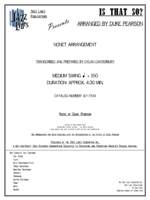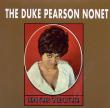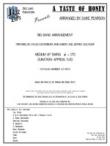IS THAT SO?
Arranged by Duke Pearson, Transcribed and Prepared by Dylan Canterbury

Cat #: JLP-7334
$45.00This item usually ships within 1 business day.
Questions?
Please call +1-518-587-1102 or email us.
Edition: Jazz Nonet Arrangement
Description: Swing - Medium
Publisher: Jazz Lines Publications
Among Duke Pearson's many compostions, "Is That So?" is perhaps one of the best known and most frequently covered. In fact, the song was initially recorded several months earlier in a quintet format by trumpeter Lee Morgan. The unique instrumentation of this recording, with Les Spann's flute being used throughout the ensemble portions, creates a delightfully light feel to the larger ensemble's overall sound.
The piece, a 24-bar form, begins with a simple rhythmic and harmonic introduction that pops up again a few more times before things wrap up. The main melody is about as simple as it gets, revolving around a single note, but a disarming harmonic structure produces an unmistakeable warmth and vulnerability, coaxed to the maximum by Johnny Coles' trumpet. The second eight-bar section is the same single note melody up a minor third, but the introduction is recycled down a whole step to vary things up a little bit. The third eight bar section is the single note melody down a whole step from its initial key, ending with an ascending line to return the melody to its home key for the second melody statement.
This second statement has a subdued shout chorus quality to it. The volume never gets too loud, but the colorful horn writing (pay particular attention to the color tones in the trombone part) adds an undeniable depth. In addition to these new fleshed out harmonies, the introduction riff is "sped up" by shifting briefly to 3/4 time, which serves as a very clever rhythmic variation that can catch one's ears off guard on first listen. Pearson's piano accompaniment is based largely off of the ensemble figures, and has been transcribed accordingly.
The original recording features solos from Pearson on piano and George Coleman on tenor saxophone, but chord changes have been included for each instrument to allow for solos to be added or opened up. After the final solo, the band returns to the melody once more. The piece ends with the same introductory sequence, this time played down a fourth from the original key. The volume level tapers off to barely above a whisper, eventually settling on a hushed Fmaj7(#11) chord that brings the piece to an appropriately lovely end.
The transcription has been done for the band's original instrumentation of trumpet, flute, alto (which doubles briefly on flute), tenor, baritone, trombone, piano, bass and drums. An optional guitar part has also been included. We sincerely hope you enjoy playing this tune as much as we enjoyed preparing it for you!
Flute
Alto Saxophone/Flute
Tenor Saxophone
Baritone Saxophone
Trumpet
Trombone
Guitar (Optional)
Piano
Bass
Drums








